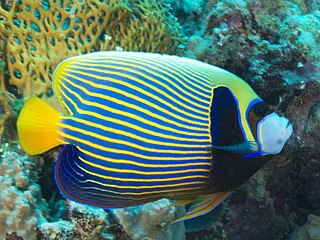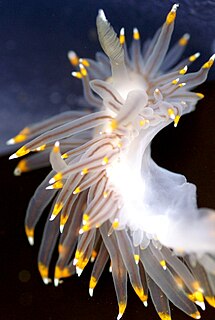
Squid are cephalopods in the superorder Decapodiformes with elongated bodies, large eyes, eight arms and two tentacles. Like all other cephalopods, squid have a distinct head, bilateral symmetry, and a mantle. They are mainly soft-bodied, like octopuses, but have a small internal skeleton in the form of a rod-like gladius or pen, made of chitin.

Nudibranchs are a group of soft-bodied, marine gastropod molluscs which shed their shells after their larval stage. They are noted for their often extraordinary colours and striking forms, and they have been given colourful nicknames to match, such as "clown," "marigold," "splendid," "dancer," "dragon," or "sea rabbit." Currently, about 3,000 valid species of nudibranchs are known.

The emperor angelfish is a species of marine angelfish. It is a reef-associated fish, native to the Indian and Pacific Oceans, from the Red Sea to Hawaii and the Austral Islands. This species is generally associated with stable populations and faces no major threats of extinction. It is a favorite of photographers, artists, and aquarists because of its unique, brilliant pattern of coloration.

Janolus is a genus of small to large sea slugs, or more accurately nudibranchs, marine gastropod mollusks, in the family Proctonotidae.

Callistoctopus macropus, also known as the Atlantic white-spotted octopus, white-spotted octopus, grass octopus or grass scuttle, is a species of octopus found in shallow areas of the Mediterranean Sea, the warmer parts of the eastern and western Atlantic Ocean, the Caribbean Sea, and the Indo-Pacific region. This octopus feeds on small organisms which lurk among the branches of corals.

Coastal fish, also called inshore fish or neritic fish, inhabit the sea between the shoreline and the edge of the continental shelf. Since the continental shelf is usually less than 200 metres deep, it follows that pelagic coastal fish are generally epipelagic fish, inhabiting the sunlit epipelagic zone. Coastal fish can be contrasted with oceanic fish or offshore fish, which inhabit the deep seas beyond the continental shelves.

Tritoniopsis elegans is a species of dendronotid nudibranch. It is a marine gastropod mollusc in the family Tritoniidae and is found in the western Indo-Pacific. It was first described by the French naturalist Jean Victoire Audouin in 1826, the type specimen being found in the Red Sea.

Tritonia hamnerorum is a species of dendronotid nudibranch. It is a marine gastropod mollusc in the family Tritoniidae.

Eubranchus exiguus is a species of small sea slug, an aeolid nudibranch, a marine gastropod mollusc in the family Eubranchidae.

Doto cuspidata is a species of sea slug, a dendronotid nudibranch, a marine gastropod mollusc in the family Dotidae.

Okenia leachii is a species of sea slug, a Dorid nudibranch, a marine gastropod mollusc in the family Goniodorididae.

Onchidoris proxima is a species of sea slug, a dorid nudibranch, a shell-less marine gastropod mollusc in the family Onchidorididae. This species is found in the northeastern and northwestern parts of the Atlantic Ocean. It is also reported from the northeastern Pacific Ocean. Previously in the genus Adalaria this species was moved to Onchidoris as a result of a molecular phylogeny study.

Zelentia pustulata is a species of sea slug, an aeolid nudibranch, a marine gastropod mollusc in the family Trinchesiidae.

Catriona aurantia is a species of sea slug, an aeolid nudibranch, a marine gastropod mollusk in the family Trinchesiidae. It was incorrectly synonymised with Catriona gymnota from the Western Atlantic but shown to be a distinct species by DNA analysis.

Calma is a genus of marine nudibranch in the family Calmidae.

Pinnoctopus cordiformis is a species of octopus found around the coasts of New Zealand.

Halecium muricatum, commonly known as the sea hedgehog hydroid, is a species of hydrozoan in the family Haleciidae. It occurs mainly in arctic and northern temperate waters, in both the Atlantic and Pacific Oceans.

Lamellaria perspicua, commonly known as the transparent lamellaria, is a species of small, slug-like sea snail, a marine gastropod mollusc in the family Velutinidae. It is native to the northeastern Atlantic Ocean and the Mediterranean Sea where it feeds on colonial ascidians.
Polycera tricolor, commonly known as the three-color polycera, is a species of sea slug, a nudibranch, a shell-less marine gastropod mollusc in the family Polyceridae. It occurs in the Pacific Northwest, ranging from southern Alaska southward to northern Mexico, at depths down to about 60 m (200 ft).


















